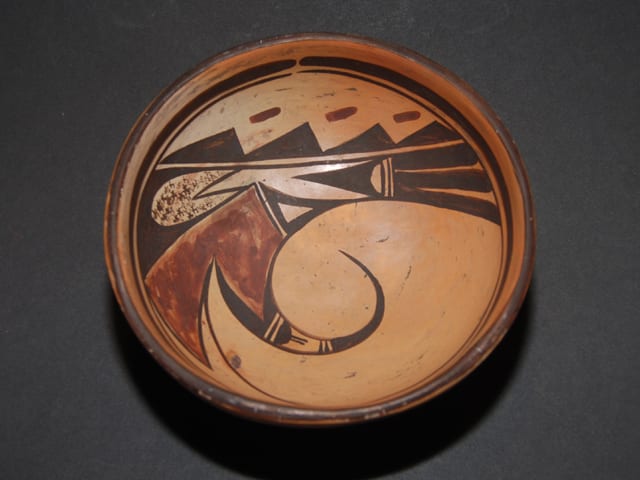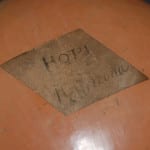The blotchy red paint indicates a pre-1930 date of manufacture. The bowl is very well formed with a thick, uncrackled slip that shows the polishing on the bottom. On the inside, a small piece of the slip has flaked off, which revealed a darker reddish underbody.
Given the skilled painting, I originally thought that there was some probability that this bowl was by Nampeyo. During a visit to his home (4/23/09) Ed Wade rejected this suggestion out-of-hand. He suggested it might have been made by Paqua Naha, though this remains just a suggestion. The “Bird Hanging from Sky Band” design was an early Nampeyo design adopted from Sikyatki ware (see the discussion in Appendix B) and the design has been widely used by other Hopi-Tewa potters, both in the Nampeyo family and by others. (For other pots in the collection with versions of the Bird Hanging from Sky Band design, see the Category List.)
The painting on 2006-08, however, has a particularly skilled composition.
First, the design flows across the bowl with a singular energy, yet is composed of contradictory elements. The three tail images are followed by a right-pointing black arrowhead, which is itself followed by a right pointing unpainted form. This rightward energy is thrown upward by two red points: the lower red point deflects the energy into the central black curved feather, which pulls the viewer’s eye to the center of the bowl. The upper red point carries the energy into a pointed area formed by the two black lines that merge into the lower framing ring, which carries the viewer’s eye back to the linear tails. It is as if once the viewer’s gaze enters the design, that energy becomes trapped into the spiraling central image of the bowl. The sky band area is internally contradictory, with the pointed negative area pointing to the central image and the three downward black triangles anchoring the avian image to the sky band. The three small red dashes visually link the sky band area to the red portion of the avian image. Second, the use of negative space is used here both as background to frame the design as part of the design itself, an unusual feature. Finally, the overall quality of the painting is confident, bold and impulsive.




